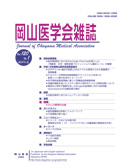

Journal of Okayama Medical Association
Published by Okayama Medical Association<Availability>
Full-text articles are available 3 years after publication.
Permalink : http://escholarship.lib.okayama-u.ac.jp/19234
胸腔内下大静脈急性閉塞に関する実験的研究 第2編 下大静脈急性閉塞の肝循環に及ぼす影響, 特に肝細静脈圧並びに肝静脈血酸素飽和度, 血清電解質の変動について
飯田 豊
岡山大学医学部砂田外科教室
発行日
1959-03-15
抄録
Stagnation in portal beds was considered to be a causative factor for death after acute occlusion of intrathoracic portion of inferior vena cava in Part Ⅰ. To clarify this point, changes in pressure of hepatic vein and portal vein, and oxygen content in both were studied under various conditions as used in the previous experiment. Following results were obtained. 1) Occlusive pressure of hepatic venule and portal pressure rise rapidly and remarkably, reaching one and a half times of normal value, and marked stagnation in liver and portal beds develops. These changes return to normal immediately after release of caval occlusion. 2) Oxygen content of portal blood markedly decrease to such a degree of 52 per cent of normal value and anoxia of liver ensues. These changes are slightly alleviated under hypothermia, however, concomitant occlusion of descending thoracic aorta produces no effect on them. 3) Potassium level in hepatic vein markedly increase after caval occlusion, which is further exaggerated by occlusion of descending thoracic aorta. Hypothermia, however, prevent its increase considerably. 4) Blood containing a large amount of potassium stagnated in portal beds flows into systemic circulation after release of caval occlusion, however, hyperkalemia does not develop to produce an effect on cardiac rhythm.
ISSN
0030-1558
NCID
AN00032489
